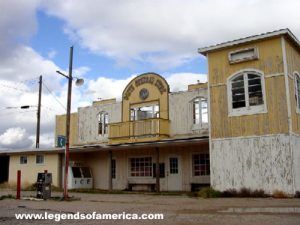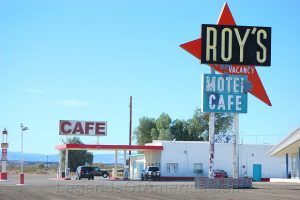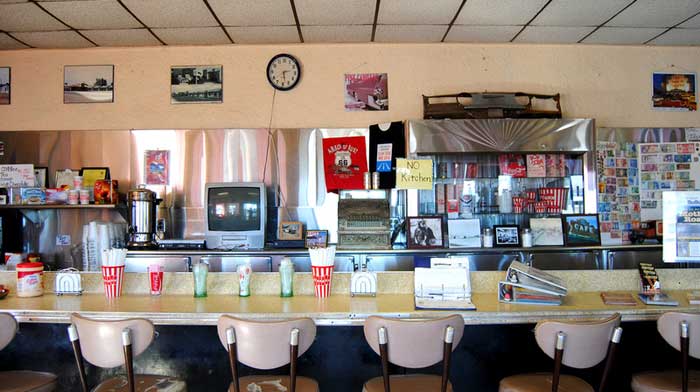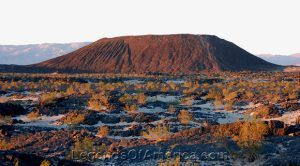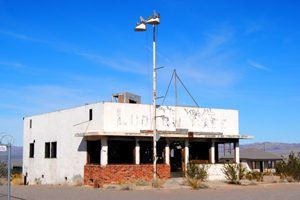~~
Interstate 40 left in its wake more than 100 miles of old Route 66 that is today littered with ghost towns. From, Goffs near Needles, California all the way to Ludlow, where the Mother Road picks back up with I-40, the desert is littered with relics from the past, and little more.
While driving this dry, barren stretch of battered highway, one can only imagine how difficult it would have been to have traveled it as a fleeing dust bowler in the 1930s. With dreams of “beautiful California” and its golden opportunities dancing in their heads, what a letdown it must have been to arrive in this sweltering bit of desert.
If you are a ghost town enthusiast, this old stretch of the road is a dream come true with a plethora of crumbling buildings and photo opportunities. But if you’re looking for quaint stopping points, curio stands, or open gas stations, restaurants, or motels, you won’t find it on this abandoned piece of pavement.
Exiting off of I-40 at US 95 North, you will turn left onto Goffs Road, which will lead you down a forty-mile stretch of near-nothingness.
This pre-1931 alignment of Route 66 was once home to several towns, nothing of which can be seen today, including Ibis, Bannock, and Homer, before reaching what is left of Goffs.
Goffs – A Crusty Ghost
This ghost town has a few interesting remnants including an old General Store and a 1914 schoolhouse that has been renovated by the Mojave Desert Heritage and Cultural Association and now houses a museum. The association maintains a collection of historical materials inside the schoolhouse and dozens of artifacts outside, including vehicles and mining equipment. The rest of the town was a lonely sight with nary a soul around and littered with junk and falling down relics of the former mining industry.
On to what was once the small town of Fenner, old Route 66 crosses under I-40 and continues on to Essex, where you can see the post office and the remains of an old gas station, out in the middle of nowhere. Beyond Essex, were once the towns of Danby and Summit, of which nothing remains today.
On down the road, you will come to Chambless, which used to have a gas station, a cafe, and several cabins. These buildings are still intact behind a tall wired fence. This one-time oasis in the desert was a popular spot for the long-ago travelers of the Mother Road, as it was one of the few places with trees, and the gas station/market once sported a wide covered porch to shade the weary travelers.
About a mile and a half west of Chambless you will see what’s left of the Road Runner’s Retreat, which once provided a welcome respite during the long hot drive across the Mojave Desert.
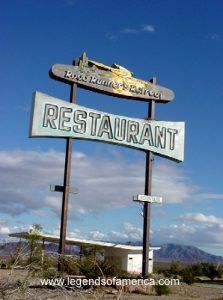
The Road Runner’s Retreat Restaurant and Gas Station once offered a respite during the long hot drive across the Mojave. Kathy Weiser-Alexander, December 2004
Amboy – No More Burgers at Roy’s (for now)
As you move on towards Amboy, you’ll begin to notice that the bank on the north side of the highway is filled with rock-strewn graffiti of the many people who pass this way.
Amboy is an intact town of ten buildings and supposedly twenty residents. However, when we were there it was totally deserted and Roy’s Cafe was closed. The town was originally owned by Roy and Velma Crowl in the 1930s and the cafe, motel, and service station were built somewhere around 1938. The Crowl’s had two children who helped them with the business – Lloyd Irwin and Betty.
Over the years the station, motel, and cafe served thousands of customers who would rave about Roy’s burgers and the service that they received along that desolate stretch of Route 66. In those days, Amboy was an oasis in the desert where hot and tired travelers could stop for food, a cool drink, mechanical services, and gas, while a big smile and a kind voice awaited them at Roy’s Cafe and Motel.
In the very early days, Roy Crowl had a small plane that he kept in a hangar behind the Cafe and used it once to rescue a woman who had fallen down into Amboy Crater. He also used it to fly his grandchildren around, taking in the view of the desert when they came to visit. Roy was also an entrepreneur, as he owned additional real estate in Sedona, Arizona, and Cherry Valley, California.
As the children grew up, Lloyd moved to Twenty-Nine Palms, California about 50 miles southwest of Amboy but continued to travel back daily as he worked in the salt mines east of Amboy. In the meantime, a man named Buster (Herman) Burris rode into town on horseback and got a job working for Roy. He soon fell in love with Roy’s daughter Betty and they married. After Roy passed away, Buster and Betty continued to run the services with the same excellent service until the late 1970s when Betty died of cancer.
Later, Buster would remarry a woman named Bessie, and the two continued the tradition of exceptional care of travelers through the years. During this time, Buster was known to open his doors clearly marked “Closed for Thanksgiving” to weary tourists out of gas or stranded. The cafe was renowned for its burgers, chili and other homemade delights as travelers stopped for a welcome respite on the long, hot, desert stretch of road. Buster continued to change tires on trucks and busses right up until the day he retired, at more than 80 years old.
Buster finally sold the town in 1995 and moved to Twenty-Nine Palms where he passed away in the year 2000. The two guys who bought the town primarily used the site to host movie companies and photo shoots. Though the restaurant was still open at times, the hours were sporadic.
Early in 2005, Buster’s widow, Bessie foreclosed on Amboy and sold it at a foreclosure sale in late February.
Fortunately for Route 66 enthusiasts, the new buyer was a man named Albert Okura, who is dedicated to preserving the old Mother Road. He purchased the 690-acre town, lock, stock, and barrel for $425,000 – a bargain in California! Okura owns the Juan Pollo restaurant chain, as well as the very first McDonald’s restaurant in San Bernardino, which today, operates as a museum.
Okura has plans to restore Amboy’s gas station, convenience store, diner, 20 motel rooms, eight motel cottages, and four houses to their 1950s-era grandeur.
He has already made progress. As of 2009, the Amboy Cafe has reopened as a gift store, which sells Route 66 and Amboy merchandise and souvenirs. Plans are still in the works to reopen it as a restaurant, but a number of improvements are still needed before that dream can become a reality.
Two and a half miles west of Amboy, the Amboy Crater rises above the desert floor. This volcano that erupted some 10,000 years ago was once an active Route 66 tourist attraction. Today it sits silently in the desert reminiscing of better days, along with the scattered remnants of the rest of the road.
Six miles west of Amboy once stood the town of Bagdad, which has been totally obliterated today. You will also pass by the old sites of Siberia and Klondike, which, like Bagdad, are nothing more than names on an old map. At last, you reach Ludlow, where you finally see some signs of life.
Ludlow Died Twice
Though Ludlow is a virtual ghost town, you will see a few open businesses due to its proximity to I-40. Founded in 1882 as a water stop for the Central Pacific Railroad, the water was hauled from Newberry Springs in tank cars. Before long, gold was discovered in the area and Ludlow began to grow until the mining petered out in the early 1900s. Declining for the first time, Ludlow saw a revival when Route 66 came through, becoming a busy rest stop along the new highway. Ludlow died a second death when I-40 replaced the Mother Road. Though there are still a few people living in the area, supporting the service businesses along the interstate, the town is mostly littered with the decaying buildings of its former past.
On the other side of the railroad tracks behind the old settlement of Ludlow is an interesting cemetery surrounded by a rusty wire fence. Here, nameless graves are marked by a couple of dozen wooden crosses, leaving no testament to those who died here many years before.
The original road dies beyond Ludlow, as it once traveled to the south side of I-40. However, by joining the north frontage road, you will soon be riding on the real thing again in about two miles.
Newberry Springs Has Seen Better Days
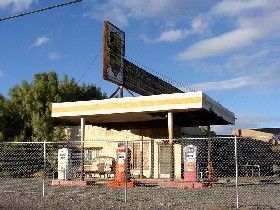
An abandoned Whiting Brothers Gas Station in Newberry Springs, California vt Kathy Weiser-Alexander, 2004
About thirty miles beyond Ludlow, you will come to Newberry Springs, which has long been a source of water in the dry Mojave Desert. Though the town wasn’t founded until 1911, the wagon trains heading to California on the old Mormon Trail in the mid-1800s made this place a regular stopping point along their travels. Located on an ancient lake, Newberry Springs has a large basin of underground water, the first water point for wagon trains west of the Colorado River.
While in Newberry Springs, be sure to visit the Bagdad Cafe, a Route 66 survivor that was once called the Sidewinder Cafe. Behind a high chain link fence, you can also view the remains of an old Whiting Brothers Gas Station.
Daggett Survives
Continuing to travel another 12 miles or so, you will reach Daggett, a town rich in history. Originally founded in the 1860s, the town boomed when silver was discovered in the Calico Mountains north of Daggett in the early 1860s. Just a few years later, borax was also discovered and began to be actively mined. Daggett soon became the mining supply and support center for the many mines in the area.
By 1902, Daggett was supported by three borax mines, had three saloons, two restaurants, a lumberyard, several stores, and the old Stone Hotel.
There are several vintage buildings in Daggett including Alf’s Blacksmith Shop, which has been standing since 1894; the Stone Hotel, built in the 1870s, said to have hosted the likes of Governor John Daggett, Tom Mix, and Wyatt Earp; and a one time Visitors Information Center that opened in 1926. Now, a private residence, this building once invited newcomers to California as well as housing a cafe and service station.
Before heading on down the Mother Road to Barstow, be sure to take a side trip just seven miles north of Daggett to the historic ghost town of Calico, California.
© Kathy Weiser/Legends of America, updated December 2020.


